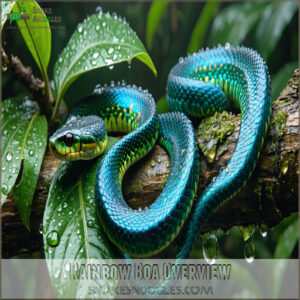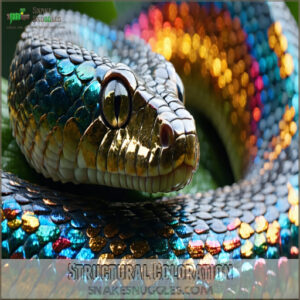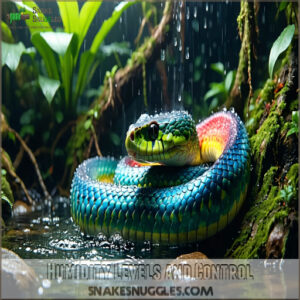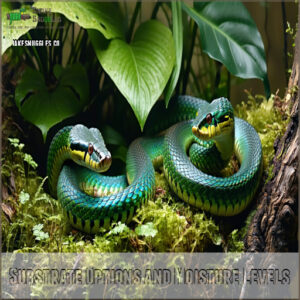This site is supported by our readers. We may earn a commission, at no cost to you, if you purchase through links.

These gentle giants from South America’s rainforests typically stretch 4-6 feet long and can be your companion for up to 20 years.
Don’t let their size fool you – they’re known for their calm, docile nature, making them perfect for patient handlers.
Each rainbow boa sports unique patterns and that famous holographic shine, thanks to microscopic ridges on their scales.
Master their specific humidity needs, and you’ll discover the secret to keeping these spectacular serpents in prime condition.
Table Of Contents
- Key Takeaways
- Rainbow Boa Overview
- Physical Characteristics
- Habitat Setup
- Diet and Feeding
- Health and Care
- Frequently Asked Questions (FAQs)
- Can a rainbow boa be a pet?
- Are rainbow boas venomous?
- How hard is it to take care of a rainbow boa?
- Is a rainbow boa endangered?
- What color is a rainbow boa?
- Where do rainbow boas come from?
- What is a Brazilian rainbow boa?
- Are rainbow boas easy to keep?
- How much does a rainbow boa cost?
- Why are rainbow boas so beautiful?
- Conclusion
Key Takeaways
- You’ll find rainbow boas are medium-sized, non-venomous snakes that grow 4-6 feet long and live 15-20 years when properly cared for, making them manageable long-term pets.
- Your rainbow boa’s most striking feature is its iridescent scales, which create a rainbow-like shimmer due to microscopic ridges that refract light rather than pigmentation.
- You’ll need to maintain specific environmental conditions – temperatures between 75-90°F and humidity levels of 70-80% – to keep your rainbow boa healthy and thriving.
- You’re looking at a gentle, docile species that makes an excellent pet for patient handlers, though you’ll need to invest $200-500 initially and provide regular feeding of appropriately-sized rodents every 7-14 days.
Rainbow Boa Overview
You’ll learn about rainbow boas, a type of non-venomous snake known for their beautiful, shimmering scales.
They come from Central and South America and can live a long time if you take good care of them.
Species Description
Rainbow boas, scientifically Epicrates cenchria, are non-venomous, medium-sized snakes known for their iridescent rainbow snake shimmer.
Species variation creates exciting color morphs, a key aspect of boa genetics, and this iridescence effects results from light reflecting off their scales.
They aren’t boa constrictors, though, and their enchanting appearance and manageable size make them a popular choice among reptile enthusiasts, particularly due to their iridescent appearance and manageable size.
More on their origins next!
Origin and Distribution
So, you’re curious where these rainbow boas hang out?
Brazilian Rainbow Boas, Epicrates cenchria, are mainly found slithering around the Amazon River Basin in South America.
Their geographic range stretches across the continent, showing off habitat diversity from rainforests to grasslands.
Understanding their population dynamics and conservation status is key for responsible ownership.
Size and Lifespan
So, you’re curious about how big your slithery friend will get?
Adult rainbow boa size averages 4-6 feet, but some reach a rainbow boa full grown size closer to 7!
Females are generally larger.
These fascinating constrictors are native to Central and South American rainforests, as detailed in this comprehensive rainbow boa guide.
A rainbow boa’s lifespan expectancy is impressive:
- 15-20 years in the wild.
- 20+ years in your care!
- Size factors include genetics and care.
- Maturity stages impact boa rainbow size.
Understanding the aging process and growth rates helps guarantee a long, healthy life for your rainbow boa.
Temperament and Handling
Generally docile, rainbow boas are known for their calm demeanor.
However, each snake has a unique personality.
Handling tips include gentle interaction and stress reduction through slow movements.
Taming techniques involve regular, short handling sessions.
Are rainbow boas friendly? With patience and proper handling, your rainbow boa can become a relaxed companion.
Physical Characteristics
You’ll learn about the rainbow boa’s unique scales, which give them a cool shimmery look.
They come in different colors and patterns, so you’ll find out how to tell them apart.
Color Patterns and Iridescence
Beyond the basic rainbow boa description, their iridescent scales create a mesmerizing sheen effect, a key part of their appeal.
This holographic appearance isn’t from pigments but microscopic ridges refracting light.
Like a prism, these iridescent scales create a rainbow, enhancing the pattern variation found in color genetics.
From iridescent black boa morphs to classic patterns, rainbow boa iridescence sets them apart.
This iridescent rainbow snake truly shines.
Weight and Body Condition
A healthy rainbow boa boasts good muscle tone, easily seen when handling.
Regular scale inspection prevents issues.
Is your boa a bit plump or skinny?
Weight fluctuation is normal, especially after feeding.
Like checking your own Body Mass Index, monitor your rainbow boa size and rainbow boa weight.
Adjust feeding strategies if needed, especially for a baby rainbow boa.
Proper rainbow boa care guarantees a healthy rainbow boa weight.
Color Morphs and Variations
A healthy weight keeps your rainbow boa vibrant.
Beyond basic health, let’s look at color variations.
Rainbow boa morphs come in a dazzling array of colors and patterns.
These variations, driven by color genetics, create unique scale shine and pattern variance.
Understanding iridescent scales is essential for appreciating the beauty of rainbow boas.
Some popular morphs include:
- Hypo rainbow boa
- Pastel rainbow boa
- Pied rainbow boa
Structural Coloration
Beyond the stunning variety of color morphs, the true magic lies in the rainbow boa’s iridescent sheen.
This "wow" factor comes from structural coloration.
Think of their scales like tiny prisms, bending light to create those vibrant, iridescent colors.
This light interference creates a rainbow boa description unlike any other, even an iridescent black boa can shimmer!
The effect is amplified after shedding, revealing the full glory of their scale structure and color refraction.
Habitat Setup
You’ll need to create a comfortable home for your rainbow boa.
This includes the right size, temperature, humidity, and substrate for a healthy and happy snake.
Enclosure Size and Materials
Picking the right rainbow boa enclosure is key.
A good terrarium design is vital for your snake’s well-being.
You can find helpful products for a suitable rainbow boa setup.
Consider these factors when setting up your brazilian rainbow boa enclosure size:
- Size: Match the enclosure to your boa’s length – a snake enclosure should be about 10% longer.
- Materials: Glass or plastic terrariums work best.
- Screen Tops: Partial covering helps keep humidity just right.
- Ventilation Systems: Good airflow is essential, but don’t let it dry out the enclosure setup.
Temperature Gradient and Lighting
To keep your rainbow boa comfy, create a temperature gradient using a basking light and a heating pad controlled by a digital thermostat.
Aim for a thermal gradient between 75-90°F, and use thermometers to monitor temperature fluctuations.
Lighting cycles aren’t critical, but a UVB light can boost their colors.
Heat sources should be regulated with a thermostat.
Humidity Levels and Control
For a thriving rainbow boa, maintaining proper humidity is key.
Aim for 70-80% humidity levels.
A hygrometer is essential; guarantee accurate readings with regular hygrometer calibration.
Proper snake terrarium humidity control involves understanding humidity control methods to create an ideal environment.
- Ditch dry air: Low humidity can lead to shedding issues and respiratory problems.
- Boost moisture: Use a humidity mister, fogging systems, or mist timers.
- Hydration station: Provide a large water bowl for soaking and drinking.
- Retreat to relaxation: A humid hide offers a moist sanctuary for your boa.
Substrate Options and Moisture Levels
Your rainbow boa’s substrate affects humidity levels.
For ideal moisture control, choose from these substrate types:
| Substrate | Water Absorption | Humidity Levels | Soil Quality |
|---|---|---|---|
| Sphagnum Moss | High | High | Excellent |
| Cypress Mulch | Medium | Medium | Good |
| Orchid Bark | Low | Low | Fair |
| Coconut Husk | High | High | Excellent |
Moist sphagnum peat moss and other choices meet rainbow boa humidity requirements.
Consider appropriate sphagnum moss reptile products for easy substrate management.
Maintain appropriate humidity levels for a thriving boa.
Diet and Feeding
You’ll learn what to feed your rainbow boa, like appropriately sized rodents.
It’s also important to know how often to feed them, which changes as they grow from babies to adults.
Prey Items and Meal Size
Proper prey selection is key for your rainbow boa’s health.
Meal portion size should match the widest part of their body.
Think pinky mice for babies, and adult mice or rats for grown-ups.
Food variety, like feeder mice and (less often) live rodents, mimics their natural hunting strategy.
For a closer examination into snake dietary needs, explore this detailed snake species diet and feeding guide.
A good diet summary: match the meal to your boa’s size, which encompasses the idea of proper prey selection.
Feeding Frequency and Schedule
Getting your snake’s meal timing right makes all the difference in their growth rates and overall health.
Your feeding schedule should adapt to your boa’s age and size.
Here’s what works best for ideal snake nutrition:
- Feed babies and juveniles every 5-7 days with appropriately sized feeder mice
- Give adults their meals every 10-14 days, adjusting food quantity based on weight
- Watch for feeding cues between meals – if your boa’s cruising the tank, it might be chow time
Supplements and Vitamins
A well-balanced diet of whole prey items typically provides all the nutrients your rainbow boa needs.
You’ll only need to think about calcium supplements for breeding females or during specific health conditions.
For ideal snake health and nutrient balance, you can occasionally dust prey with vitamin powder.
You can purchase rainbow boa vitamin products online.
While not strictly necessary for non-breeding snakes, a 50/50 mix of calcium and multivitamins can help prevent vitamin deficiency.
Feeding Techniques and Safety
Armed with your snake nutrition knowledge, let’s master safe feeding techniques.
Use feeding tongs to offer pre-killed prey, keeping your fingers safe and your snake calm.
Always thaw frozen meals in sealed bags with warm water, and feed your rainbow boa in a separate container to avoid substrate ingestion.
After meals, give your snake 48 hours of peace to prevent regurgitation.
Health and Care
You’ll need to watch out for common health issues in your rainbow boa, including feeding problems, obesity, dry eyes, and parasites that can affect their well-being.
Regular vet check-ups and proper care will help you catch these issues early, keeping your scaly friend happy and healthy for their 20-30 year lifespan.
Anorexia and Feeding Problems
Sudden feeding refusal in your rainbow boa shouldn’t set off immediate alarm bells.
Check for stress triggers like environment changes or upcoming sheds.
If your snake shows food aversion, make certain temps stay between 75-90°F and humidity at 70-90% .
Offer pre-killed food , in a hide, and if anorexia persists beyond a month while losing weight, consult a reptile vet .
Obesity and Weight Management
Your rainbow boa‘s weight gain prevention starts with monitoring portion sizes and feeding frequency.
Track your snake’s body condition by checking for visible spine ridges and proper muscle tone.
Maintain healthy feeding habits by spacing meals 7-10 days apart and choosing appropriately-sized prey.
For a thorough guide, explore effective snake weight management strategies.
Keep your rainbow boa active by providing climbing branches and varied terrain, which helps control metabolic rate naturally while preventing obesity.
Dry Eyes and Respiratory Infections
Looking out for your boa’s health means catching respiratory infections early.
If you notice open-mouth breathing or bubbles from the nostrils, seek vet care immediately.
Young Brazilian rainbow boas need extra attention, as their high humidity needs make them prone to respiratory issues.
Watch for dry eyes too – they can signal underlying problems, and proper treatment with prescribed medications can prevent complications.
Parasites and Skin Issues
Tiny black dots on your Brazilian Rainbow Boa’s scales aren’t just dirt – they’re likely mite infestations that need immediate attention.
Scale rot and fungal infections can quickly compromise your snake’s health, but you can spot trouble early.
Here are key warning signs to watch for:
- Black specks around eyes and heat pits
- Discolored or raised belly scales
- Blisters or skin lesions
- Unusual soaking behavior
These signs indicate potential health issues, such as scale rot and fungal infections, which can be detrimental to your snake’s well-being.
Regular Veterinary Check-Ups
While you’re watching out for skin issues and parasites, don’t forget yearly health exams for your rainbow boa.
Your vet will check their weight, eyes, and overall condition during these visits.
They’ll spot potential problems before they get serious and make sure your snake’s shedding and feeding patterns are normal.
Schedule check-ups more often during breeding periods – it’s worth every penny for your snake’s long-term wellbeing.
Frequently Asked Questions (FAQs)
Can a rainbow boa be a pet?
Like a living jewel, these stunning serpents make excellent pets.
They’re gentle, manageable in size, and live 20-30 years.
You’ll need proper humidity, temperature control, and regular feeding to keep them healthy.
Are rainbow boas venomous?
You’ve got nothing to worry about with these stunning snakes – they’re completely non-venomous.
Instead of venom, they use their muscular bodies to constrict prey, making them safe and fascinating pets.
How hard is it to take care of a rainbow boa?
Managing a first-time pet snake isn’t rocket science.
You’ll need to maintain specific humidity and temperature levels, feed them properly, and clean their enclosure regularly.
It’s manageable with proper research and dedication.
Is a rainbow boa endangered?
You’ll be happy to know that these snakes aren’t endangered.
Though they face some challenges from habitat changes and pet trade collection, their population remains stable across Central and South America.
What color is a rainbow boa?
You’ll spot stunning reddish-brown or brownish base colors adorned with black markings.
What makes them truly special is their iridescent sheen that creates a mesmerizing rainbow effect when light hits their scales.
Where do rainbow boas come from?
You’ll find these vibrant creatures living in lower Central America (Costa Rica and Panama) and across South America east of the Andes mountains.
They stretch all the way to northern Argentina’s diverse landscapes.
What is a Brazilian rainbow boa?
You’ll discover these stunning snakes are medium-sized, non-venomous constrictors with gorgeous iridescent scales. They’re native to South America’s rainforests, and they’ll amaze you with their rainbow-like sheen under light.
Are rainbow boas easy to keep?
You’ll need commitment for these pets.
They require specific humidity levels above 70%, steady temperatures between 75-85°F, and careful handling.
With proper setup and regular maintenance, they’re manageable for dedicated intermediate reptile keepers.
How much does a rainbow boa cost?
Shimmering like precious gems, these exotic pets range from $200 to $500 for standard morphs at pet stores and breeders. You’ll pay up to $1000 for rare color variations and patterns.
Why are rainbow boas so beautiful?
Microscopic ridges in your snake’s scales act like tiny prisms, creating that stunning rainbow effect when light hits them.
You’ll notice this natural phenomenon most when they’re moving under bright light.
Conclusion
Like a living kaleidoscope, your rainbow boa brings nature’s artistry into your home.
When you master their care requirements – from precise humidity levels to proper feeding schedules – you’ll be rewarded with a fascinating pet that can thrive for two decades.
Remember, every rainbow boa has unique needs and personality quirks.
Stay attentive to their behavior, maintain their environment carefully, and you’ll enjoy watching your iridescent friend flourish under your dedicated care.

















